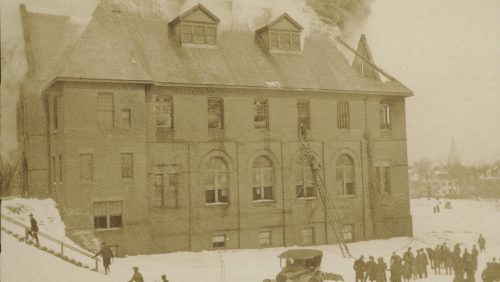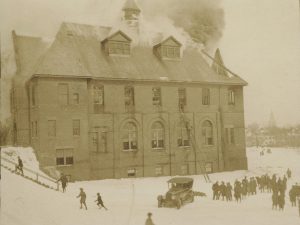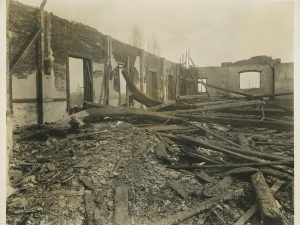The Mystery of Six Campus Fires in a Month
Originally published in the Trinity Ivy, 1923.

Between February ninth and February twenty-third Trinity was treated to–or suffered from–a mystery which still has the State police bewildered and which long ago caused the Hartford police to throw up their hands and drop the case.
During that period no less than six mysterious, incendiary fires broke out, the climax of the series coming on February eighteenth when Alumni Hall was gutted and completely destroyed.
#1 Faculty Office
The first blaze was discovered in an upper shelf of a bookcase in Dr. McCook’s office, just off the German room. Little attention was paid to this as practically no damage was done. Those who thought about it much were mystified as to a possible origin, but the college body as a whole soon forgot the accident.
#2 Public Speaking Room
This fire on February ninth was followed on February twelfth by a Sunday night blaze in the Public Speaking room. Chance only discovered this, as no one had occasion to pass the room on Sunday night. Some men in the Union, directly underneath, heard a crackling, and investigated, being met by clouds of smoke when they battered in the door at the north end of the room. Mulligan, ’25 turned in an alarm to which two companies responded. The room was so filled with smoke that it was necessary to smash two of the ornamental windows. Finally, after both fire extinguishers and water had been poured on to the blaze it was conquered. The floor and wainscoting along one third of the west wall of the room were burned. The center of the fire seemed to be a steam pipe, and Fire Chief Moran gave that as the probable cause of the flames. However, it was soon found that the radiator and pipe in question had no steam turned into them. Investigation showed that the fire started on the floor and worked underneath around the pipe. All was quiet for a week.
#3 Alumni Hall
Just after twelve o’clock on Saturday, February eighteenth, the familiar cry of FIRE! rang over the campus, and flames burst through the windows in the east end of Alumni Hall. Rich, ’24 turned in the box alarm, and Tilton, ’20, from his desk in the college office saw the smoke and sent in a still alarm. Four companies and a squad of police responded. By the time the firefighters arrived the entire room was a seething mass. Students, working quickly and quietly, had removed all the apparatus and athletic material from the lower floors of the building and carried it to the archway. However, it was impossible to enter the Hall itself, and the class banners, dating from 1878 were lost.
Students then helped the firemen drag the heavy hose into the building, and followed up the crews, with big cans of hot coffee, made at the President’s house and at Commons. Engine Co. No. 1.5 ran a hose through the main door, Squad A took a line through to the athletic field, and used it from the running track of the gymnasium, thus probably saving the remainder of the structure. A third company took a line around the east side of the building and up a ladder placed against the south wall. Soon the hose was cut by falling slate, and the pipe crew left its position a few minutes before a dormer window fell directly on the ladder, breaking it in half. The fourth company attacked the fire from the north side of the building but were driven off by showers of sparks, and clouds of heavy, acrid smoke. The fire was set in the painted canvas scenery stored back of the stage, and, clinging to the well waxed floor, quickly ran the length of the building. Twenty minutes after the alarm was sounded the roof began falling in at the east end. Soon the tall cupola slowly crumbled and fell directly into the mass of flames, which shot skyward. In less than an hour, the room which had been the scene of many a Promenade, commencement, examination, and formal function, was a smoking, steaming mass of embers. The great beams of the roof had fallen, taking with them the brick wall at the south end. The firemen remained on hand until six o’clock. Meanwhile Fire Chief Moran, Assistant Chief, in charge of fire prevention, Ramsden, and Superintendent Hurley of the State Police, began an investigation.
All doubts as to the origin of the fires were now displaced by a firm belief in incendiarism. The last time Alumni Hall was used was two weeks before, when the class of 1923 held its Junior Promenade. No one had occasion to enter the upper floor after that function. Particularly, no one had occasion to go back of the stage, where the fire started.
#4 Latin Room
This $15,000 blaze was followed, on February 20, by a fire in the Latin room. Here the cause was even more evident. Professor Barrett had dismissed a class at 2:45, and, after gathering up some papers, left the room, leaving the door unlocked, as was his custom. At 3:20 an alarm was sent in. The door was locked with a night latch, and all windows were closed. Students with fire extinguishers, battered in the door, and firemen smashed in the windows on the west side of the building. The fire was soon put out, with chemicals. Investigation showed that it was started in a waste paper basket under Professor Barrett’s desk. The desk was completely burned, and the flames spread along the top of the platform and followed an electric conduit pipe under the flooring. The tops of the joists under the floor were charred and the bottoms clean. It was self-evident that oil had been used and a quantity poured down around the pipe. The speed with which the fire spread also pointed to oil. This fire, linked up with that in the Public Speaking room, tallied exactly, pointing to the same hand.
The Hartford Police assigned Detective Sergeants Hallisey and Madigan to the case, and two independent investigations were conducted. Immediately after this fire steps to place a student guard on the buildings were taken, with Fred Stone, coach of baseball and assistant in the physical training department, in charge. Four men were placed in Jarvis Laboratories and four in Boardman Hall. Squads, working in regular relief, patrolled the outside of the buildings.
#5 Student Room in Jarvis Hall
Notwithstanding this vigilance, the pyromaniac (for such he was now believed to be) set his fifth fire that night. The guard changed at eleven o’clock. At 11:38 fire was discovered in room No. 41 Jarvis Hall. This time it was in a bureau in one of the bedrooms.
Hunkins and Montgomery, who lived in the room were both out during the evening, Hunkins returning just in time to see his bureau carried out of the section door. Students had extinguished this fire before the department responded to the alarm. Apparently, there was little in the bureau, indicating that the mysterious fiend was not bent upon destruction of private property.
All was quiet over Washington’s birthday, the “bug” evidently enjoying the holiday at home. The guard was now put on a workable basis.
Through most of the night five state police, beaded by Sergeant Arthur Pinnell, and assisted by a student guard under Cuningbam ’22 and Brill ’23, patrolled the entire campus. Early in the evening and early in the morning the students handled the business alone. The guard did not go on until eight o’clock. This was soon observed by the unknown “Bug,” and on the twenty-third, a few minutes past six, when most of the men are going to dinner, the sixth and last fire was discovered.
#6 Study in Jarvis Hall
This time in room No. 39 Jarvis Hall, directly under the scene of the fifth fire. The flames were confined to the closet in the study, which was thoroughly gutted. Only five minutes before the fire was discovered the occupant of the room, Mulligan, ’25, left it to go to dinner. In those five minutes the flames ate clear through the heavy closet door.
Detective Sergeants Hallisey and Madigan of the Hartford police arrested George Mulligan, ’25, of Bergensfield, N. J., on circumstantial evidence following this fire in his own room. They based their case on the fact that he was one of the first at every fire, and that he could not account for every minute of his time just before each of the series of fires. Not having sufficient evidence to secure a warrant for arson, Mulligan was held over night on a technical charge of breach of peace. He was released on bail furnished by his father and his hearing was fixed for Friday, March third.
Superintendent Hurley and Detective Edward Hickey, investigating for the State police, made no comment when they learned of Mulligan’s arrest, and continued their search. Twice during the week between his arrest and hearing Mulligan was subjected to psychiatric examinations by Dr. Paul Vaterman, an alienist of Hartford. These conclusively proved his sanity, and, when the case was called in police court, it was immediately dropped for lack of evidence.
United States Commissioner Frederick Corbett, Mulligan ‘s attorney took occasion to criticize the hasty action of the Hartford police in the case, and stated that they might have treated the suspect in a more gentlemanly manner. It is said that Prosecuting Attorney Nathan Schatz went to States Attorney Hugh M. Alcorn before the case was brought up and asked that the Hartford police be allowed to use the evidence which the state police bad gathered. The request was refused and it is said that Mr. Alcorn added his condemnation to the burden which the city police are bearing. Soon after this fiasco, the Hartford police stated that they had conducted the investigation as far as they could and would drop the case.
Superintendent Hurley, assisted by Detective Hickey and Assistant Fire Chief Ramsden, is continuing the investigation in his capacity as State Fire Marshall. Hickey is on the campus daily, on the lookout for stray bits of evidence. It is rumored that the state police are satisfied as to the identity of the pyromaniac, but are unwilling to act until convicting evidence is secured. Thus far, to all outward appearances, the criminal is as far from capture as he was on February tenth.
At least half a dozen men have come under suspicion at various times, but no case against them appeared. When the mystery is finally cleared up it will not only be a distinct triumph for the police working on the ca e, but will furnish some novelist with material for a “best-seller” detective story.

